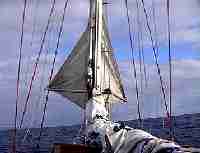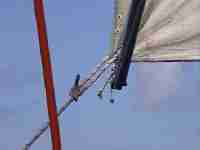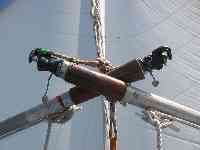| |||||||
The Twizzle Rig can be set up by one man on the foredeck and another crew in the cockpit tending the sheets. It took about fifteen minutes to rig at sea. |
|
|
|
|
|
|
|
|
|
|
|
|
Trimming the twizzle rig The poles should be sloping down and veed forward to the clews. The jibs set well up to 60 degrees each side of a dead run. Just ease the windward sheet and harden the leeward sheet a foot or two as one would do with a spinnaker. You will see how the surface of the sea is dappled by the downforce off the jibs. This indicates a good lifting force to the bows. It
has been written that the twizzle rig stops all
rolling. This is not true. What it does stop
is the dreaded continuous 'death rolling' of a twin
jib or main and jib goosewinged rig. The yacht will
roll as it drops off a cross swell but the twizzle
rig dampens it after three or four swings with the
universal joint swinging across the deck spilling
some wind from one jib and then the next. See the
video clip twizzle.mpg As the wind freshens, the jib sheets can be eased and the jibs rolled up. No adjustment is required to the up/downhaul - the poles simply vee more. Reefing can continue from the cockpit till just a pair of 'ears' are showing, veed downwind like a dart which gives excellent directional stability. Striking the twizzle rig Basically the opposite of setting the rig. Ease sheets and roll up the jibs from the cockpit till the poles are roughly fore and aft. Go on deck and lower the universal joint to the deck. Lightly lash to the mast to stop the poles rolling about. Release one pole from the universal, let off the outhaul and run the pole aft. Unclip the outhaul from the pole end and stow the pole. Sheet in a bit to stop the jib 'ear' flapping. Repeat for the other pole. Ease sheets and fully roll up the twizzle jibs. Go to the bows and clear away the downhaul. Coil up the sheets and outhauls and stow on the pulpit port and starboard. Make fast the uphaul and stow the universal joint with the downhaul and preventer. For Windward Work If she has two jib furling gears then the fore or outer gear can carry the twizzle jibs and the inner gear the genoa. If she has one furling gear, there is an alternative to changing sails on the foil on a frisky foredeck. The twizzle jibs can be sheeted as one. However, with a high cut twizzle jib, it is difficult to reach the furled clews to change sheets. On Alma I could just reach them when standing on the pulpit but that was rather hairy on a plunging deck. On a bigger craft it may be a bosun's chair job to reach the furled clews - no joke in 6m / 20 foot swells. On Alma, the clews could just be reached so the twizzle sheets and outhauls were removed. A short rope strop with a block running on it was made fast to each clew. A pair of jib sheets were tied to the base of the block and run port and starboard. The block running on the strop equalised the tension on each clew. As the sails were not quite the same size, the clews were in different positions when sheeted in and this method gave a good enough set to sail 'full and bye' and certainly close winded enough to claw off a lee shore. We only used this in practice just to prove its value as Alma had a genoa and the twizzle jibs on their own dedicated furling gear foils. On
a larger craft, or where the clews are cut so high
they cannot easily be reached, another method can
be employed using the twizzle sheets and outhauls.
On the wind on port tack, the port jib is sheeted hard in on the winch while the starboard jib lays over the port jib and is held in place by high wind pressure and some tension on the 'outhaul come sheet' but not needing the winch or a sheet block on a car for sail shape. Going about, let off the 'outhaul' on the 'lazy' starboard jib first, then the port jib sheet as she goes past the wind. Haul in on the starboard jib sheet with the winch then smooth in the port jib, now the 'lazy jib', resting on the starboard jib and tensioned a bit by its 'outhaul come sheet' direct to a spare cleat.
|
||
More ...A
description of the setup, setting and striking...
|
||


